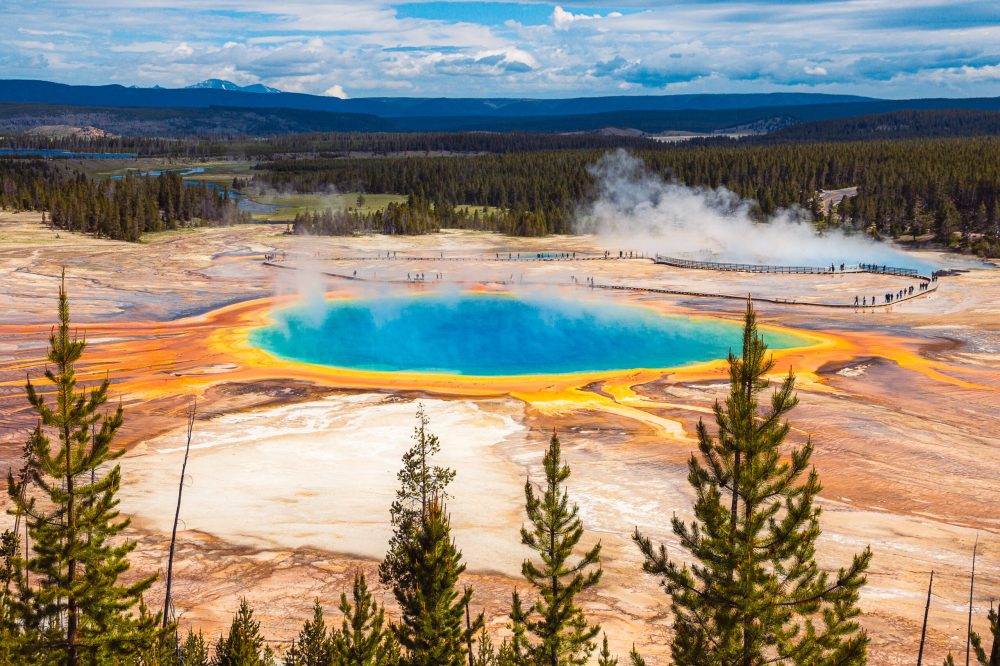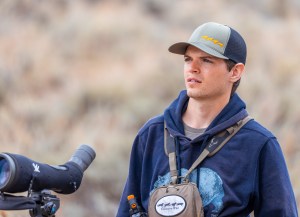The Spring Awakening
By YW Naturalist Evan Watts
Finally, a bit of sunshine. Forty-degree temperatures. The sound of snowmelt dripping from the rooftops. A mountain bluebird flutters overhead as the first grizzly bears emerge from hibernation and begin their search for winter-killed elk carcasses. A brutal, cold winter is over, and spring is coming.
Spring is my favorite season in Yellowstone. It is a time when the park undergoes its most dramatic transformation of the year, as a landscape covered in feet of snow becomes a landscape of lush green grasses and vibrant wildflowers. It is when the elk, bison, deer, pronghorn, moose, mountain goats, and bighorn sheep all give birth to their young, bringing new life to the park. The valleys seem to grow fuller as new calves, fawns, and lambs begin to roam them, and the energy they bring is palpable. Trust me when I say there are very few things in this world as full of energy as a bison calf.

When the snow melts and the Lamar Valley becomes green once more, the bison return en masse to enjoy the rich feeding opportunities. Photo by Evan Watts
Wolves, coyotes, and foxes selected mates for the year months ago, and tiny pups are born in dens across the landscape. Born blind and immobile, they will be miniatures of their parents, wrestling outside the den and causing mischief by the end of spring. Their parents will stay very busy hunting with all the new mouths to feed.
Summer migrants arrive by air. The prehistoric calls of nesting sandhill cranes pierce the cold morning air as mountain bluebirds, western tanagers, and yellow-headed blackbirds add song and color to the environment. Ospreys return to their nests along the waterways, ready to feed and raise another clutch of chicks on Yellowstone’s abundant trout populations.

Mountain bluebirds are often the first sping migrants to arrive, a sign of winter’s failing grip on this region. Photo by Evan Watts
And then there’s the bears. Spring is the season of the bears. Over 3 months, thousands of bears will emerge from their dens, and their preparation for next winter begins immediately. They graze on grass, dig up tubers, hunt elk calves, and sniff out carcasses to feed on. Cubs of the year, born in the den in February, finally see the outside world for the first time. Fully-grown cubs, called subadults, will separate from their mothers, transitioning to the life of an adult bear. Male bears lumber through the remote valleys and across the high peaks, looking for mates. This activity leads to the best bear viewing opportunities of the year, something we guides miss dearly during the winter months.
Needless to say, the fauna of Yellowstone make spring such a special time here. While less recognized, the flora do the same! Bluebells, larkspur, spring beauties, and shooting stars are just a handful of the colorful wildflowers that bloom in spring. Aspens, willows, and cottonwoods regain their green leaves. And I can’t go without mentioning my favorite plant species in the park, arrowleaf balsamroot. These flowers bloom in perfect clusters, with bright green leaves and stems at the base and large, beautiful daisies sprouting from the top. They don’t last for long before drying up, but when they bloom, they accent the rolling hills of Yellowstone’s Northern Range spectacularly.
Aside from the wildlife, some of Yellowstone’s thermal features also change in spring. As snowmelt adds water to the ground, the water table rises–providing extra hydration for thermal features such as Red Spouter and Fountain Paint Pot–making them more dramatic than ever. Sunshine burns away the thick steam at Grand Prismatic Spring, pulling back the veil it creates and bringing the spring’s otherworldly colors alive and visible after a long winter shrouded in steam.

Grand Prismatic Hot Spring is vibrant and visible as air temperatures rise in spring and summer. Photo by Emil McCain
Additionally, the melting of snow and milder weather allow the park’s roads to reopen to private travel. Exploration becomes much easier as access to the park increases. Trails, long buried in snow, are now melted out, and as summer arrives and the visitors with it, the parking lots fill with people enjoying the backcountry of the world’s first national park.
Above all else, spring is a time when we get to watch Yellowstone awaken. It marks a new beginning for every manner of life found across the park, a new chapter for those working there, and a new adventure for the visitors we are lucky enough to share Yellowstone with. The spring awakening is a special time, and I look forward to experiencing many more of them in the future!
Blog written by Yellowstone Wild Guide Evan Watts
All photos courtesy of Watts Wildlife Photography.

To learn more about Evan and the rest of the Yellowstone Wild team visit our “About Us” web page.



